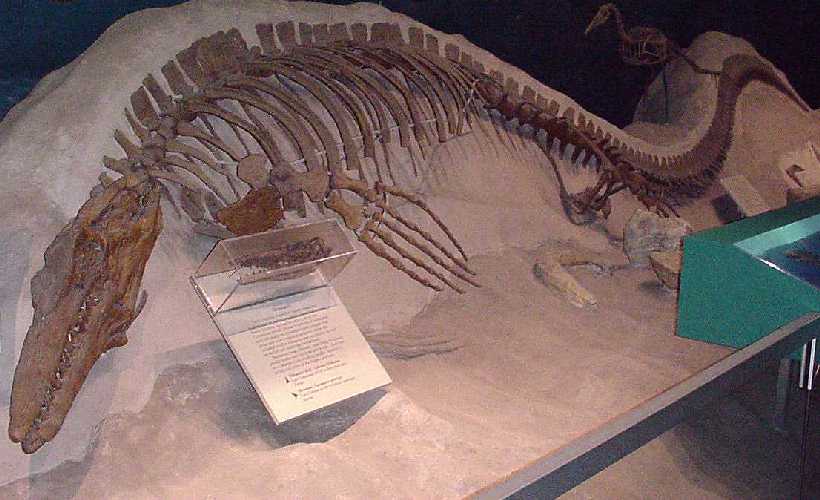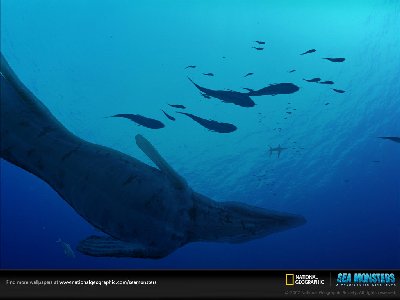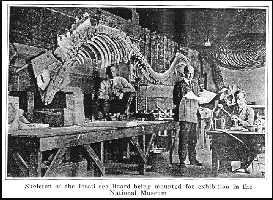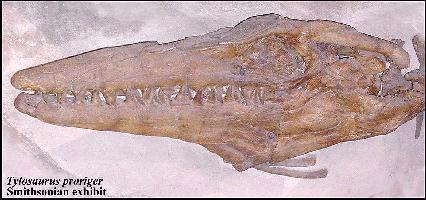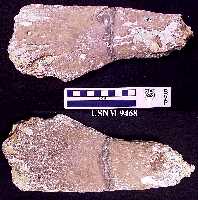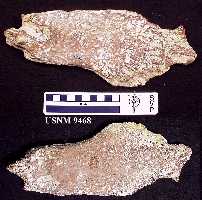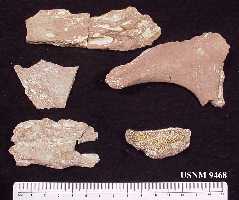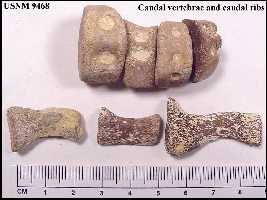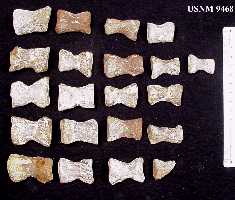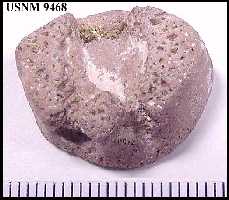|
Kansas Academy of Science.
119 Explorations of the Permian of Texas and the Chalk
of
Kansas, 1918.
CHARLES H. STERNBERG.
The splendid skeleton of Dimetrodon gigas I
collected in 1917 and sold to the United States National Museum has been mounted at last,
and is one of the world's famous specimens. I do not know of a more perfect single
individual. It came from the famous Craddock quarry discovered by the late Doctor
Williston's assistant, Mr. Miller. Through the kindness of Mr. Craddock, the owner of the
quarry, I not only collected there in 1917, but last year. Owing to the fact that the
quarry is now covered with about twenty feet of earth and clay of the toughest character
the work was very difficult and I was obliged to employ a man with a heavy team of horses,
with plow and scraper. I succeeded in securing many more or less perfect skeletons of
several species. Unfortunately, none were as perfect and capable of making into a fine
open mount as the National Museum specimen. This quarry is in the face of a hill. As I
have gone deeper and deeper into the hill the manner in which the animals were stranded
here becomes more and more apparent. On the very bottom of the quarry are innumerable
bones of very small animals, Seymoriana and other batracians, etc. They are usually
scattered and are free from matrix, consequently they are among the rarest of Permian
vertebrates that have not been injured by the encrusting silica that covers all the other
bones at higher levels, and which is so difficult. to remove. The National Museum specimen
came from near this level. Above are about four or, five feet in the heavy, fine-jointed
red clay. Though water has filtered and coated all the bones with silica, I found several
more or less perfect skeletons. Often the entire column, except the tail, with enormous
spines were present; sometimes the arches and limbs, as in the best specimen we found,
discovered by my son, George F. The longest spine of this individual was four feet.
Most of the column and tail were present. The skull was disarticulated. The arches seemed
present. Many of the spines, however, were twisted and interwoven, all the bones covered
with a thin coating of silica. As I understood Doctor Gilmore, it took two preparators a
year to prepare and mount the National Museum specimen. You will realize something of the
labor it will take to prepare this one. This, with my whole collection from the Craddock
quarry, I sold to the American Museum.
From Seymour, Tex., my boys, George and Levi, drove my
car to the Rock creek Horse quarry, near Tulia, Tex.. but the formidable mass of sand that
lay above it induced them to turn their Ford truck northward, and I joined them in the
Kansas chalk in Logon county, on Butte creek. I was so fortunate as to find a fine
tylosaur skeleton the second day in the field. There were twenty-one feet of the skeleton
present in fine chalk. The complete skull was crushed laterally, nearly the complete front
arches and limbs were present, as was also the pelvic bones and both femora. All the
vertebræ to well into the caudal region beyond the lateral spines were continuous, with
the ribs in the dorsal region. Between the ribs was a large part of
a huge plesiosaur with many half-digested bones, including the large humeri, part of the |
120
Kansas Academy of Science.
coracoscapula, phalanges, vertebræ, and, strangest of
all, the stomach stones, showing that this huge tylosaur, that was about twenty-nine feet
long, had swallowed this plesiosaur in large enough chunks to include the stomach. How
powerful the gastric juice that could dissolve these big bones! This specimen I sent to
the United States National Museum. A little Clidastes
skeleton found by my son Levi proves not only to be new, but possessed of remarkable
characters not yet described. I will only in a general way give you an idea of this little
sea lizard. It is 8 ½ feet long, skull 14 inches long. Levi in preparing the skeleton
restored the maxilla, jugals, nasals and prosquamosals, with the ends of some of the
teeth; also four of the cervical and one dorsal vertebra. These had been destroyed by
incrusting gypsum. The bifrucated coracoids, 2 inches wide, are large compared to the
scapulæ, which are only 1 ¼ inches wide. The most remarkable thing about this mosasaur
is the fact that the humeri and femora have distinct, round heads, similar to those of
mammals. Further, all the Clidastes humeri I know are broad, square bones, nearly
as broad as they are long. In this specimen the humerus is 2 ¼ inches, while it is only 1
¼ inches wide in the widest part; the same with the femur. The front paddle is 7 inches
long to ends of first row of phalanges; width only 2 ½ inches. The column is continuous
to the pygals, where they are scattered. The pelvic arches and paddles are only partially
preserved. The caudals are beautifully preserved, with a high fin in the last half of the
column; the chevron well preserved, with all of them anchylosed to the centra of the
vertebræ. The only genus among the mosasaurs where this is the case. They usually are
distinct, the proximal heads fitted snugly into little basins hewn out., as it were, from
the centra of the vertebræ. I own this new Clidastes. [now Eonatator (Halisaurus) sternbergi, described by Carl
Wiman, 1920; revised to Halisaurus by Russell (1967) and most recently to Eonatator
(novem gen.) by Bardet, et al., 2005).
We secured two specimens of Platecarpus
coryphæus of exactly the same size. One found by Levi Sternberg has much
of the head, the column, and ribs to the pygals. The second, found by George F. Sternberg,
has a very complete tail to the very end, and the pelvic arch and one paddle; other
specimens furnished the rest of the paddles. We have mounted this as a slab specimen, and
makes a skeleton 17 feet long-very impressive, indeed. George F. Sternberg found also a
very fine skull and most of the skeleton of a small Pteranodon.
The skull is only 27 inches long; missing, only the crest and front of the mandibles. Both
coracoscapula are present, with one humerus, radius, ulna, carpal joint., and most of one
elongated finger. Both hind limbs and several vertebræ and ribs. This, when prepared,
will be one of the few fine skulls of these flying reptiles. We secured also a very fine Portheus, complete, nearly, except the ends of the ribs, the
dorsal and caudal fins, and 18 caudal vertebræ. These we have restored, and we have a
fish 13 feet long, with spread of tail fins of 35 inches. These are the chief discoveries
of my last season's labor in the Permian of Texas and the chalk of Kansas.
|
